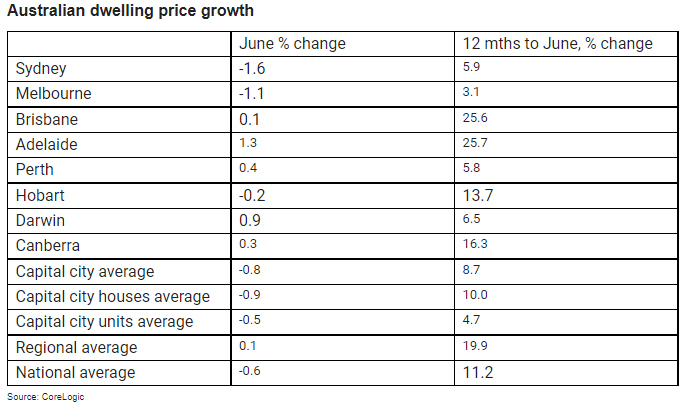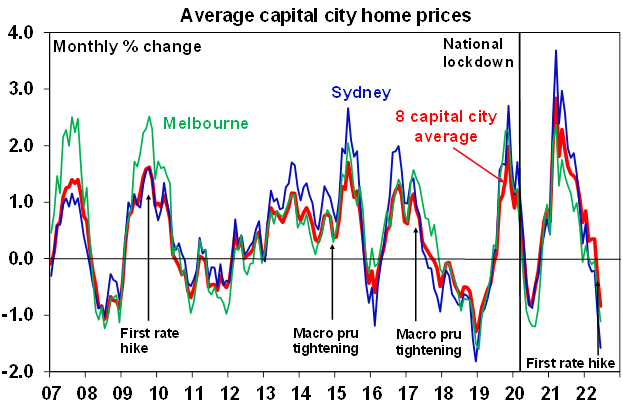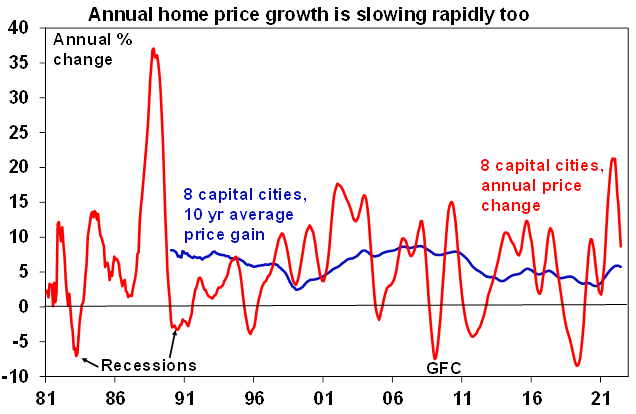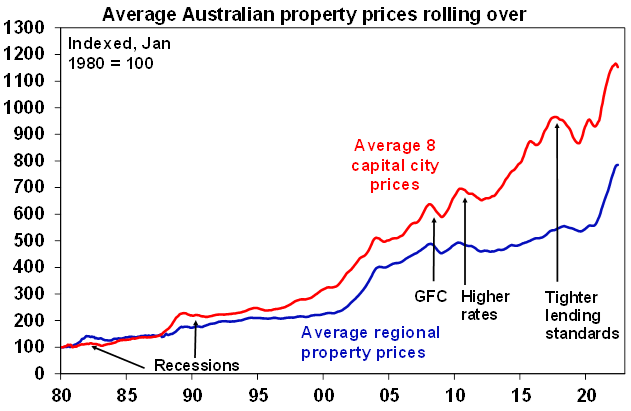Australian home price falls are accelerating, down 0.6% in June, with prices in Sydney and Melbourne down sharply. We now expect a 15-20% top to bottom fall in average home prices.Key points:
- Australian capital city average dwelling prices fell 0.8% in June according to CoreLogic, making it their second monthly decline in a row.
- Including regional dwellings, national dwelling prices fell 0.6% in the month, and they are up 11.2% year on year.
- Prices fell in Sydney for the fifth month in a row with the pace of declines accelerating to 1.6%mom and they are now down by 3.2% from their February high.
- Similarly, Melbourne prices are now down for four months in a row with price falls accelerating to 1.1% in June.
- Other cities and regional areas have also seen a sharp slowing in price gains – notably Brisbane where monthly price growth has virtually stalled after running at 2% just three months ago.
- House prices are falling faster than unit prices, after the former rose more rapidly through the boom.

The property market is slowing rapidly
Average residential property prices surged nearly 30% between their pandemic low in September 2020 to their high in April on the back of record low mortgage rates, government incentives, recovery from the lockdowns, a lack of supply and coronavirus driving a switch in consumer spending from services to “goods” including housing. However, the boom is now over and property prices are falling with the pace of decline accelerating.
The drivers of the downturn are: poor affordability; rising mortgage rates with fixed rates having gone up two to three fold from around 2% to around 5% (with one bank above 6% for some fixed rates) and variable rates now rising rapidly; a rise in new listings in Sydney, Melbourne, Hobart and Canberra; a rotation in household spending from goods back to services; cost of living pressures making it harder to save for a deposit; and a decline in consumer and homebuyer confidence.
But the main driver of the slowdown so far is the surge in mortgage rates – being able to borrow at a fixed rate of 2% or less was a key driver of the boom in prices with fixed rate lending accounting for 40-50% of new lending about a year ago. But with fixed mortgage rates now more than doubling over the last 12 months and variable rates rising rapidly this has substantially reduced the amount new home buyers can borrow and hence their capacity to pay.
The downtrend trend in monthly price gains since March last year has been led by Sydney and Melbourne, which are now seeing sharp falls. Other cities are following Sydney and Melbourne with a six months or so lag.

Source: CoreLogic, AMP
The slowdown in monthly price growth is now seeing annual price growth fall sharply too. Simple mean reversion after a period of well above 10-year average growth warns of a further slowdown ahead.

Source: CoreLogic, AMP
Of course, average home price levels have so far only seen a flick off the top after a huge boom. But further falls are likely.

Outlook – we now expect average property prices to have a top to bottom fall of 15 to 20% over the next 18 months
We expect national average property prices to fall further over the next 18 months reflecting the combination of: poor affordability; rising fixed mortgage rates; further rate hikes from the RBA pushing up variable rates; high inflation which is making it even harder to save for a deposit; higher supply in Sydney and Melbourne as a result of vendors seeking to take advantage of still high prices and some increase in distressed sales from later this year; and a rotation in consumer spending back towards services as reopening continues which may reduce housing demand.
As we have revised up our forecast for the peak in the cash rate to around 2.5% from around 2% and the property downturn is coming in a bit faster than expected we have revised our forecast for the peak to trough fall in property prices from a fall of 10-15% to a fall of 15-20%. Falls are likely to be concentrated over the next 12 months. Sydney, Melbourne and Canberra are likely to see 20% or so falls, Brisbane, Adelaide and Hobart are likely to see 15% or so declines and falls are likely to be only around 5-10% in Perth and Darwin.
The property downturn is occurring earlier relative to the timing of RBA rate hikes this cycle because of the bigger role ultra-low fixed rate mortgage lending played this time around in driving the boom. Now the surge in fixed rates over the last year has pulled the rug out from under the property boom substantially reducing new buyers’ capacity to pay well ahead of the RBA’s cash rate hike. Higher household debt ratios compared to the past are likely also playing a role. And cash rate hikes since May are now accelerating the downturn.
The fall in home prices this cycle could well see some cities – notably Sydney and Melbourne - reverse all or much of the boom in prices since their 2020 pandemic low, which will likely see a significant rise in negative equity for recent low deposit buyers.
Expanded access to home deposit schemes, the Federal Government’s “Help to Buy” scheme, NSW first home buyers swapping stamp duty for land tax next year, the tight rental property market and rising immigration levels will help provide a floor for property prices but the property market will be dominated by the cyclical impact of rising interest rates.
Just as the cut in interest rates to record lows was the key driver of the recent price boom, the surge in interest rates now underway will be the key driver of the property market ahead.
The main downside risk to our forecasts would be if the cash rate is raised to near 4% which the money market is assuming – this would more than double average household interest payments and could drive a 25-30% fall in prices.
Fortunately, this seems unlikely as the RBA only wants to cool demand enough to bring inflation back down – not crash the property market and economy.
On this front falling home prices and other signs of weakening consumer demand will ultimately help limit how much the RBA will have to raise the cash rate by and so we see the peak in the cash rate being around 2.5% rather than 4%.
The main upside risk to our forecasts would be if inflation quickly subsides allowing the RBA to ease up on the interest rate brake well before reaching 2.5% for the cash rate.
So far, the national property downswing looks like just another cyclical downswing, albeit it’s a bit steeper. But note that the 25-year bull market in capital city property prices is likely to come under pressure in the years ahead as the 30 year declining trend in inflation and hence mortgage rates which has enabled new buyers to progressively borrow more and more, and hence pay more and more for property is now likely over.
Ends
Important note: While every care has been taken in the preparation of this document, AMP Capital Investors Limited (ABN 59 001 777 591, AFSL 232497) and AMP Capital Funds Management Limited (ABN 15 159 557 721, AFSL 426455) make no representations or warranties as to the accuracy or completeness of any statement in it including, without limitation, any forecasts. Past performance is not a reliable indicator of future performance. This document has been prepared for the purpose of providing general information, without taking account of any particular investor’s objectives, financial situation or needs. An investor should, before making any investment decisions, consider the appropriateness of the information in this document, and seek professional advice, having regard to the investor’s objectives, financial situation and needs. This document is solely for the use of the party to whom it is provided.